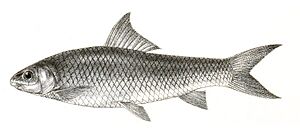Reba facts for kids
Quick facts for kids Reba |
|
|---|---|
 |
|
| Conservation status | |
| Scientific classification | |
| Synonyms | |
|
The Reba fish, also known as Gymnostomus ariza, is a type of cyprinid fish. This means it belongs to the carp family. You can find the Reba fish in several countries in Asia, including India, Nepal, Bangladesh, Afghanistan, and Pakistan.
Contents
What is the Reba Fish?
The Reba fish is a freshwater fish. It likes to live in clear rivers and large water tanks. These fish are not picky eaters. They feed on tiny living things called plankton and also on detritus. Detritus is dead plant and animal matter.
How Big Do Reba Fish Get?
Reba fish grow quite quickly. In their natural homes, they can reach lengths of about 30 centimeters (about 12 inches). That's roughly the length of a standard ruler! Interestingly, male Reba fish are usually smaller than the females.
What Does the Reba Fish Look Like?
Reba fish have thin stripes on their bodies. These stripes are mostly along their back, above a line called the lateral line. Bigger Reba fish often have a wider stripe along their side. Their color can change. They might be a dull white, grey, silvery, or even yellow. The stripes can also look more or less clear depending on the fish.
Where Do Reba Fish Live?
The Reba fish lives in many different water systems across South Asia.
- In Pakistan, you can find them in the waters of the Indus plain and nearby hilly areas.
- In India, Nepal, and Bangladesh, they live in the large river basins of the Ganges and Brahmaputra rivers.
- They are also found in other major river basins in southern India. These include the Mahanadi, Krishna, and Cauvery rivers.
- In Bangladesh, they live in the Karnapouli river and smaller basins in the Chittagong Hill Tracts.
- There have also been reports of Reba fish living in Myanmar.
Reba Fish Reproduction and Farming
Reba fish have a special time of year when they reproduce. They breed in shallow, flooded areas from June to September.
How Are Reba Fish Farmed?
Reba fish are important for aquaculture in India. Aquaculture is like farming, but for fish! In fish farms, people help the Reba fish reproduce. This is often done using a method called hypophysation.
What is Hypophysation?
Hypophysation is a way to encourage fish to lay eggs and reproduce. It involves taking a small part called the hypophysis (or pituitary gland) from one fish. This part is then prepared and injected into another mature fish. This injection helps the fish get ready to reproduce.
Collecting Young Reba Fish
Even with farming, many young Reba fish, called fry, are found naturally. You can easily find them in rivers like the Cauvery and Bhavani from July to September. They are especially common around sunrise and sunset. These young fish are collected to stock fish ponds. They are even put into seasonal waters because they grow so fast.


